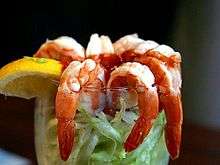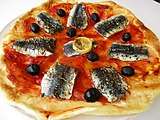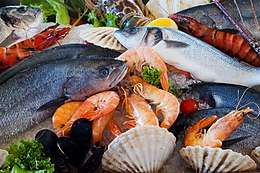Pescetarianism
Pescetarianism or pescatarianism[2] (/ˌpɛskəˈtɛəriənɪzəm/) is the practice of adhering to a diet that incorporates seafood as the only source of meat in an otherwise vegetarian diet.[1]
| Pescetarianism | |
|---|---|
  | |
| Description | |
| A pescetarian diet is a plant-based diet where seafood is the only meat.[1] | |
| Related Dietary Choices | |
| Associated and similar diets |
|
| Diet(Nutrition)#Diet classification table | |
Etymology
Pescetarian is a neologism formed as a portmanteau of the Italian word pesce ('fish') and the English word vegetarian.[1] The English pronunciation of both pescetarian and its variant pescatarian is /ˌpɛskəˈtɛəriən/, with the same /sk/ sequence present in pescato (Italian: [peˈskaːto]),[3] although pesce is originally pronounced [ˈpeʃʃe], with a /ʃ/ sound.
History
Vegans, vegetarians and pescetarians were described as people practicing similar dietary principles as those of the Vegetarian Society in 1884.[4] In the 21st century, the Vegetarian Society does not consider pescetarianism to be a vegetarian diet.[5]
Trends
In 2018, Ipsos MORI reported 73% of people followed a conventional pattern diet where both meat and non-animal products were regularly consumed, with 14% considered as flexitarians, 5% vegetarians, 3% vegans, and 3% pescetarians.[6] A 2018 poll of 2,000 United Kingdom adults found that 12% of adults adhered to a meat free diet, with 2% vegan, 6-7% ovo-lacto-vegetarian, and 4% pescetarian.[7]

As a plant-based diet, pescetarianism is similar to many traditional diets emphasizing plant foods as well as seafood.[8][9] Regular fish consumption and decreased red meat consumption are recognized as dietary practices that may promote health.[10][11]
Motivations and rationale
Sustainability and environmental concerns
Ecological sustainability and food security are growing concerns. Livestock is the world’s largest user of land, representing some 80% of total agricultural land. Beef consumption is 24% of the world's total intake of meat, but accounts for less than 2% of calories consumed worldwide.[12] The environmental impact and amount of energy needed to feed livestock greatly exceeds its nutritional value.[13][14] People may adopt a pescetarian diet out of desire to lower their dietary carbon footprint.[15][16]
Some pescetarians may regard their diet as a transition to vegetarianism, while others may consider it an ethical compromise,[17] often as a practical necessity to obtain nutrients absent or not easily found in plants.[18] Pescetarianism may be perceived as a more ethical choice because fish and other seafood may not associate pain and fear as more complex animals like mammals do.[19][20]
Health
A common reason for adoption of pescetarianism is perceived health, such as fish consumption increasing intake of omega-3 fatty acids which are associated with reduced risk of cerebrovascular disease.[21] Fish and plant food consumption are parts of the Mediterranean diet which is associated with lowered risk of cardiovascular diseases.[22] In one review, pescetarians had relatively low all-cause mortality among dietary groups.[23]
Abstinence in religion
Christianity
Marcion of Sinope and his followers ate fish but no fowl or red meat.[26] Fish to the Marcionites was seen as a holier kind of food.[27] They consumed bread, fish, honey, milk and vegetables.[26][28]
The Cathars, a Christian dualist sect, did not eat cheese, eggs, meat or milk because they were the products of coition.[29] The Cathars believed that animals were carriers of reincarnated souls and forbid the killing of all animal life apart from fish.[29][30] The Cathars ate fish which they believed were produced by spontaneous generation.[30]
In both the Roman Catholic and Eastern Orthodox tradition, pescetarianism is referred to as a form of abstinence. During fast periods, Eastern Orthodox and Catholics often abstain from meat, dairy, and fish, but on holidays that occur on fast days (for example, 15 August on a Wednesday or Friday), fish is allowed, while meat and dairy remain forbidden.[31]
The Rule of Saint Benedict insisted upon total abstinence of meat from four-footed animals, except in cases of the sick.[32] Thus, Benedictine monks followed a diet based on vegetables, eggs, milk, butter, cheese and fish where available.[33] Paul the Deacon (Cir. 775 AD) specified that cheese, eggs and fish were part of a monk's ordinary diet.[33] Walafrid Strabo, a Benedictine monk, commented that "some salt, bread, leeks, fish and wine; that is our menu".[34]
The Carthusians followed a strict diet that consisted of fish, cheese, eggs and vegetables, with only bread and water on Fridays.[32] In the 13th century Cistercian monks consumed fish and eggs.[35] Ponds were created for fish farming.[35] From the early 14th century Benedictine and Cistercian monks no longer abstained from consuming meat of four-footed animals.[35][36] In 1336, Pope Benedict XII permitted monks to eat meat four days a week outside of the fast season if it was not served in the refectory.[36]
Jerome recommended an ascetic diet of fish, legumes and vegetables.[37] Peter the Hermit, a key figure during the First Crusade was described by an eyewitness as having lived on diet of fish and wine.[38]
Judaism
Pescetarianism (provided the fish is ruled kosher) conforms to Jewish dietary laws, as kosher fish is "pareve"—neither "milk" nor "meat". In essence, aquatic animals such as mammals like dolphins and whales are not kosher, nor are cartilaginous fish such as sharks and rays, since they all have dermal denticles and not bony-fish scales. In 2015, members of the Liberal Judaism synagogue in Manchester founded The Pescetarian Society, citing pescetarianism as originally a Jewish diet, and pescetarianism as a form of vegetarianism.[39]
Hinduism
By tradition, most Hindu Brahmin communities follow a strict lacto-vegetarian diet. However, there are Brahmin sub-groups allowing the consumption of fish, such as the Goud Saraswat Brahmin community of coastal south-western India.[40] This community regards seafood in general as "vegetables from the sea", and refrains from eating land-based animals. Other Hindu Brahmin communities who consume seafood are the Maithili Brahmin, Viswa Brahmin and the Bengali Brahmin.[41] The Bengali Brahmins consume fish and are known to cook it daily.[42]
See also
- Ikaria Study — Dietary study of long-lived Ikarian people found to have semi-vegetarian diets similar to pescetarianism.
- Legal Sea Foods – Boston, Massachusetts–based network of seafood restaurants that use the "pescatarian" term in their TV advertising
- List of diets
- List of pescetarians
- Semi-vegetarianism – other forms of semi-vegetarianism that include occasional seafood or meat consumption
References
- "Definition of Pescatarian by Merriam-Webster". Merriam-Webster.
- Luna, Taryn (1 July 2015). "Legal Sea Foods launches 'Pescatarianism' ad campaign". The Boston Globe.
- "Pescato: significato e definizione". la Repubblica.
- "International Health Exhibition". The Medical Times and Gazette. 24 May 1884. Retrieved 18 May 2019.
There are two kinds of Vegetarians—one an extreme form, the members of which eat no animal food whatever; and a less extreme sect, who do not object to eggs, milk, or fish. The Vegetarian Society ... belongs to the latter more moderate division
- "Fish". The Vegetarian Society of the United Kingdom Limited. 2019.
- "An exploration into diets around the world" (PDF). Ipsos. UK. August 2018. pp. 2, 10, 11.
- Johnson, Georgia-Rose (2019-01-30). "UK diet trends". Finder UK. Retrieved 2019-05-12.
- Taylor Wolfram (1 October 2018). "Vegetarianism: The basic facts". Academy of Nutrition and Dietetics. Retrieved 21 April 2019.
- Summerfield, Liane M. (2012-08-08). Nutrition, Exercise, and Behavior: An Integrated Approach to Weight Management (2nd ed.). Cengage Learning. pp. 181–182. ISBN 9780840069245.
A plant-based diet is not necessarily a vegetarian diet. Many people on plant-based diets continue to use meat products and/or fish but in smaller quantities.
- Judith C. Thalheimer. "The pescaterian diet". Today's Dietitian. p. 32. Retrieved 2019-04-09.
- "Becoming a vegetarian". Harvard Health Publishing, Harvard University. 23 October 2018. Retrieved 19 May 2019.
- "Agriculture at a crossroads: Meat and animal feed". Global Agriculture. 2018. Retrieved 2019-04-27.
- "U.S. could feed 800 million people with grain that livestock eat, Cornell ecologist advises animal scientists". Cornell Chronicle. 1997-08-07. Retrieved 2019-04-26.
- "Tackling climate change through livestock". United Nations. 21 October 2014.
- "Carbon footprint factsheet". Center for Sustainable Systems, University of Michigan. 2018. Retrieved 19 May 2019.
- Scarborough, P.; Appleby, P. N.; Mizdrak, A.; Briggs, A. D.; Travis, R. C.; Bradbury, K. E.; Key, T. J. (June 11, 2014). "Dietary greenhouse gas emissions of meat-eaters, fish-eaters, vegetarians and vegans in the UK". Climatic Change. Springer. 125 (2): 179–192. Bibcode:2014ClCh..125..179S. doi:10.1007/s10584-014-1169-1. PMC 4372775. PMID 25834298.
- Ronald L. Sandler, Food Ethics: The Basics, Routledge, 2014, p. 74.
- Rohrer, Finlo (5 November 2009). "The rise of the non-veggie vegetarian". BBC News. Retrieved 22 July 2013.
- "Do fish feel pain? Not as humans do, study suggests". ScienceDaily. 8 August 2013.
- Rose, J. D., Arlinghaus, R., Cooke, S. J., Diggles, B. K., Sawynok, W., Stevens, E. D., & Wynne, C. D. L. (2014). "Can fish really feel pain?" Fish and Fisheries, 15(1), 97–133. doi:10.1111/faf.12010
- Chowdhury, R.; Stevens, S.; Gorman, D.; Pan, A.; Warnakula, S.; Chowdhury, S.; Ward, H.; Johnson, L.; Crowe, F.; Hu, F. B.; Franco, O. H. (30 October 2012). "Association between fish consumption, long chain omega 3 fatty acids, and risk of cerebrovascular disease: systematic review and meta-analysis". BMJ. 345 (oct30 3): e6698. doi:10.1136/bmj.e6698. ISSN 1756-1833. PMC 3484317. PMID 23112118.
- Widmer, R. Jay; Flammer, Andreas J.; Lerman, Lilach O.; Lerman, Amir (1 March 2015). "The Mediterranean diet, its components, and cardiovascular disease". American Journal of Medicine. 128 (3): 229–238. doi:10.1016/j.amjmed.2014.10.014. ISSN 0002-9343. PMC 4339461. PMID 25447615.
- Schwingshackl, Lukas; Schwedhelm, Carolina; Hoffmann, Georg; Lampousi, Anna-Maria; Knüppel, Sven; Iqbal, Khalid; Bechthold, Angela; Schlesinger, Sabrina; Boeing, Heiner (26 April 2017). "Food groups and risk of all-cause mortality: a systematic review and meta-analysis of prospective studies". American Journal of Clinical Nutrition. 105 (6): 1462–1473. doi:10.3945/ajcn.117.153148. ISSN 0002-9165. PMID 28446499.
- Committee on the Toxicological Effects of Methylmercury, Board on Environmental Studies and Toxicology, National Research Council, Council, National Research; Studies, Division on Earth Life; Sciences, Commission on Life; Toxicology, Board on Environmental Studies and; Methylmercury, Committee on the Toxicological Effects of (2000). Toxicological Effects of Methylmercury. ISBN 978-0-309-07140-6.
- "Experts Say Consumers Can Eat Around Toxins In Fish". ScienceDaily. Retrieved 7 January 2015.
- May, Gerhard; Greschat, Katharina. (2013). Marcion und seine kirchengeschichtliche Wirkung / Marcion and His Impact on Church History. De Gruyter. pp. 213-216. ISBN 978-3110175998
- Fontaine, Petrus Franciscus Maria. (1994). Gnostic Dualism in Asia Minor During the First Centuries, A.D. II. Brill Academic Publishing. p. 84. ISBN 978-90-50-63346-8
- Tyson, Joseph B. (2006). Marcion and Luke-Acts: A Defining Struggle. University of South Carolina Press. p. 35. ISBN 978-1-57003-650-7
- Preece, Rod. (2008). Sins of the Flesh: A History of Ethical Vegetarian Thought. UBC Press. p. 139. ISBN 978-0-7748-15093
- Johnston, William M. (2000). Encyclopedia of Monasticism. Fitzroy Dearborn Publishers. p. 252. ISBN 978-1-57958-090-2
- "The Fasting Rule of the Orthodox Church". www.abbamoses.com.
- Keevill, Graham; Aston, Mick; Hall, Teresa. (2017). Monastic Archaeology. Oxbow Books. p. 54. ISBN 978-1-78570-567-0
- Butler, Edward Cuthbert. (1919). Benedictine Monachism: Studies in Benedictine Life and Rule. London: Longmans, Green. p. 44
- Riché, Pierre. (1978). Daily Life in the World of Charlemagne. University of Pennsylvania Press. p. 171. ISBN 0-8122-1096-4
- Barber, Bruno. (2004). The Cistercian Abbey of St Mary Stratford Langthorne, Essex. Museum of London Archaeology Service. p. 158. ISBN 978-1901992380
- Kerr, Julie. (2006). Life in the Medieval Cloister. Continuum. pp. 48-50. ISBN 978-1847251619
- Shaw, Teresa M. (1998). The Burden of the Flesh: Fasting and Sexuality in Early Christianity. Fortress Press. p. 112. ISBN 0-8006-2765-2
- Claster, Jill N. (2009). Sacred Violence: The European Crusades to the Middle East, 1095-1396. University of Toronto Press. p. 39. ISBN 978-1-4426-0058-4
- "Pescetarian Society Home Page". The Pescetarian Society. 2019.
- Axelrod, P; Fuerch, MA (1998). "Portuguese Orientalism and the making of the village communities of Goa". Ethnohistory. 45 (3): 439. doi:10.2307/483320. JSTOR 483320.
- Chakravarti, A. K. (December 1974). "Regional Preference for Food: Some Aspects of Food Habit Patterns in India". The Canadian Geographer. 18 (4): 395–410. doi:10.1111/j.1541-0064.1974.tb00212.x.
- Sinclair-Brull, Wendy. (1997). Female Ascetics: Hierarchy and Purity in an Indian Religious Movement. Curzon Press. p. 158. ISBN 0-7007-0422-1
| Look up pescetarian in Wiktionary, the free dictionary. |